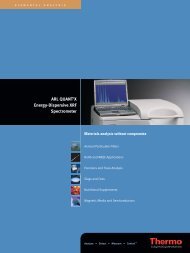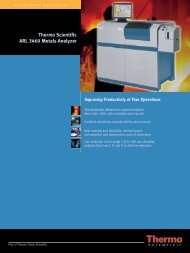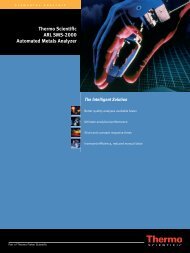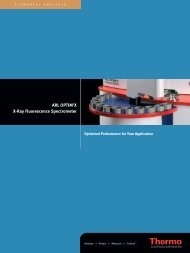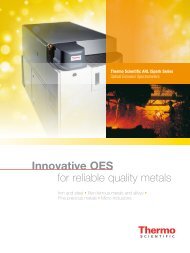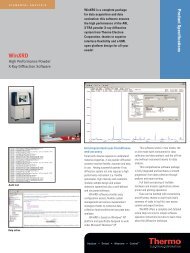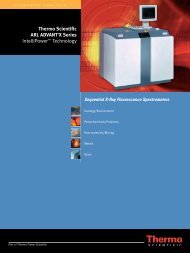ARL X'TRA Powder X-ray Diffraction System
ARL X'TRA Powder X-ray Diffraction System
ARL X'TRA Powder X-ray Diffraction System
Create successful ePaper yourself
Turn your PDF publications into a flip-book with our unique Google optimized e-Paper software.
e l e m e n t a l<br />
a n a l y s i s<br />
<strong>ARL</strong> X’TRA<br />
<strong>Powder</strong> X-<strong>ray</strong> <strong>Diffraction</strong> <strong>System</strong><br />
Uncompromised Intensity and Resolution<br />
Analyze • Detect<br />
• Measure • Control
<strong>ARL</strong> X’TRA<br />
<strong>Powder</strong> X-<strong>ray</strong> <strong>Diffraction</strong> <strong>System</strong><br />
<strong>ARL</strong> X’TRA<br />
High performance powder X-<strong>ray</strong> diffraction system<br />
The <strong>ARL</strong> X’TRA is an advanced multi-purpose<br />
system designed for academic or industrial<br />
analytical laboratories. It is ideal either for<br />
routine analysis or highly demanding<br />
applications requiring dedicated accessories.<br />
Analytical performance, ergonomics and<br />
safety are the major characteristics of this<br />
outstanding instrument from Thermo Electron<br />
Corporation.<br />
With 20 years of experience in the<br />
North America market (including under the<br />
former name of Scintag) – and high<br />
precision Swiss engineering with excellence<br />
in X-<strong>ray</strong> spectroscopy, the <strong>ARL</strong> X’TRA offers<br />
a leading edge in the field of X-<strong>ray</strong> powder<br />
diffraction technology.<br />
Thermo's design of the <strong>ARL</strong> <strong>X'TRA</strong> is<br />
based on a vertical θ-θ Bragg-Brentano<br />
geometry for convenient sample preparation<br />
and sample handling. With the unique<br />
Peltier detector technology, ultimate<br />
performance in both angular and energy<br />
resolution can be achieved without using β-<br />
filters or monochromators. This elegant<br />
design yields higher diffraction intensities<br />
and superior resolution compared to<br />
traditional point detectors.<br />
Depending on the type of analysis or<br />
sample type, the system can be easily<br />
reconfigured using pre-aligned Plug & Play<br />
accessories such as temperature chambers,<br />
parallel beam options, texture goniometer.<br />
The modular approach of the <strong>ARL</strong><br />
X’TRA powder diffraction instrument<br />
provides full flexibility without any<br />
compromise in performance for a large<br />
range of applications covering both<br />
inorganic and organic polycrystalline<br />
materials.<br />
A wide range of analytical<br />
techniques<br />
X-<strong>ray</strong> diffraction is a versatile and nondestructive<br />
technique that reveals detailed<br />
structural and chemical information about<br />
the crystallography of materials.<br />
• Identification of single or multiple phases<br />
in an unknown sample<br />
• Quantification of known phases of a<br />
mixture<br />
• Crystallography – solving crystal structure<br />
• Non ambient analysis – crystal structure<br />
changes with temperature, pressure or<br />
gas phase<br />
• Surface and thin film analysis<br />
• Texture analysis<br />
A broad range of materials<br />
Natural or manufactured materials of<br />
organic or inorganic chemistry can be<br />
characterized with this technique. Some<br />
typical materials are listed here:<br />
• Chemicals<br />
• Pharmaceutical substances<br />
• Environmental dusts<br />
• Asbestos<br />
• Rocks<br />
• Clay minerals<br />
• Zeolites<br />
• Polymers<br />
• Metals<br />
• Cement and building materials<br />
• Forensics<br />
• Pigments<br />
Pharmaceuticals Geology Ceramics
Environment Building materials Chemicals
<strong>ARL</strong> X’TRA<br />
<strong>Powder</strong> X-<strong>ray</strong> <strong>Diffraction</strong> <strong>System</strong><br />
Technique<br />
The most flexible goniometer geometry<br />
It is now well accepted that for the majority of<br />
the powder X-<strong>ray</strong> diffraction experiments, the<br />
vertical θ-θ Bragg-Brentano setup replaces the<br />
traditional vertical or horizontal θ-2θ geometry.<br />
The main reason is that the sample stage does<br />
not move during the scan and therefore even<br />
loose powders or liquids can be analyzed.<br />
In this geometry, the <strong>ARL</strong> X’TRA offers<br />
the best configuration providing superior<br />
flexibility for future upgrades or<br />
reconfigurations with optional accessories.<br />
The reliability and accuracy of this system<br />
is achieved thanks to closed loop servo motors<br />
with optical encoders.<br />
Choose the best trade-off between<br />
intensity and resolution<br />
The continuous slit aperture capability of the<br />
<strong>ARL</strong> X’TRA system allows an instrument<br />
operator to choose the optimum balance<br />
between intensity and angular resolution.<br />
Continuous adjustment capability allows<br />
instrument operators to optimize the slit<br />
settings in accord with the crystallographic<br />
quality of the materials.<br />
As shown in Figure 4, an angular<br />
resolution < 0.04° FWHM can be measured<br />
easily in standard configuration without using<br />
beam path accessories and with a normal<br />
scan speed (0.1° 2θ/s).<br />
A precise control of the radial and axial<br />
collimation of the beam is ensured with<br />
micrometer-controlled slits and an<br />
exchangeable/removable set of soller slits.<br />
Precise “zero plane” adjustment<br />
Sample height is critical to get accurate data<br />
in Bragg-Brentano geometry (standard setup)<br />
and to get best intensity in parallel beam<br />
configuration.<br />
The standard sample stage on the <strong>ARL</strong><br />
X’TRA includes a micrometer based stage<br />
with height adjustment and height position<br />
block. Depending on the shape and dimension<br />
of the sample, the micrometer adjustment can<br />
be used to precisely adjust the specimen<br />
height at the scale of 10 µm. The precision in<br />
the micrometer adjustment also yields<br />
numeric traceability of the aligned position.<br />
Modular stage design<br />
The modular design or so called “Plug & Play”<br />
of the <strong>ARL</strong> X’TRA allows users to exchange<br />
pre-aligned sample stages without requiring a<br />
lengthy realignment procedure. The standard<br />
sample stage incorporates two mechanical<br />
pins that precisely orient both the translational<br />
and rotational orientation of the stage relative<br />
to the goniometer. Complete reconfiguration of<br />
the diffractometer is now achievable in<br />
several minutes instead of hours.<br />
Unique Peltier cooled Si(Li) solid-state<br />
detector<br />
For more than 20 years, solid-state detectors<br />
have been a popular detection option on our<br />
instruments. The latest version is a Peltier<br />
cooled Lithium drifted Silicon solid-stage<br />
detector (see Figure 1). It is sealed under high<br />
vacuum with passive getters that ensure the<br />
long term stability of the vacuum.<br />
The 5 stage Peltier pyramid allows to<br />
cool down the Si(Li) crystal down to a<br />
temperature close to -100°C and therefore,<br />
the internal noise of this detector is extremely<br />
low:
6000<br />
5000<br />
4000<br />
A.U.<br />
3000<br />
2000<br />
Figure 3: Speed of acquisition with the <strong>ARL</strong><br />
1000<br />
X’TRA on a Zeolite 4A sample: In green, the<br />
data measured in less than 5 minutes and in<br />
red, the data measured in 20 minutes<br />
0<br />
5 15 25 35 45 55<br />
2Θ<br />
0.2<br />
Raw data<br />
FWHM data<br />
FWHM Cagliotti fit<br />
0.16<br />
A.U.<br />
0.12<br />
0.08<br />
FWHM °<br />
Figure 4: Full Width at Half Maximum (FWHM) of the NIST<br />
LaB6 (SRM660a) reflections as a function of 2θ CuKα. The<br />
red curve shows the Cagliotti fit and in blue, the XRD raw<br />
data measured in 2 hours without primary or secondary<br />
beam monochromator<br />
0.04<br />
0<br />
10 60 110 160<br />
2Θ°
<strong>ARL</strong> X’TRA<br />
<strong>Powder</strong> X-<strong>ray</strong> <strong>Diffraction</strong> <strong>System</strong><br />
WinXRD for data acquisition and<br />
data analysis<br />
Best performance from the X-<strong>ray</strong> diffraction<br />
system is ensured with WinXRD, a<br />
Windows ® NT based software program<br />
compatible with Microsoft Windows ® 2000<br />
and XP. This comprehensive software<br />
package is fully integrated and facilitates a<br />
smooth progression from data collection<br />
through analysis and report writing.<br />
Data can be handled with convenience<br />
and efficiency thanks to audit trails, user<br />
access controls and export functions.<br />
The data collection part offers the<br />
possibility to perform different types of<br />
measurements:<br />
• Symmetric θ:θ normal scans<br />
• Asymmetric θ scans (e.g. for grazing<br />
incidence)<br />
• And finally ω rocking scans.<br />
Data analysis software includes various<br />
analytical features like:<br />
• Basic data treatment (background<br />
substraction, smoothing, peak extraction,<br />
profile fitting, etc.)<br />
• Search-match routine using the ICDD or<br />
user database<br />
• Quantitative Phase Analysis<br />
• Crystallite size determination<br />
• Crystallographic analysis (indexing and<br />
unit cell refinement) 2D and 3D graphic<br />
display for multiple graphs<br />
• Texture analysis with 2D and 3D<br />
polefigure display<br />
Advanced third party software allow<br />
more specific data analysis like:<br />
• GSAS for any Rietveld analysis (structure<br />
refinement and FPQ)<br />
• SIROQUANT for routine minerals<br />
quantification based on the Rietveld<br />
method<br />
• POPLA or BEARTEX for texture analysis<br />
and more.<br />
Enhanced capabilities with<br />
accessories<br />
In addition to the superior performance of<br />
the standard instrument configuration mainly<br />
dedicated to phase identification & phase<br />
quantification, the system can be quickly<br />
reconfigured with accessories providing<br />
superior analytical capabilities like:<br />
• Batch mode for routine measurements<br />
with the multi-position sample changer<br />
• Texture analysis in reflection mode with<br />
the half-circle cradle<br />
• Texture analysis in transmission mode<br />
with the transmission stage<br />
• Non-ambient experiments from low<br />
temperature to very high temperature<br />
conditions under vacuum, air, inert gases<br />
or controlled humidity conditions<br />
• Air sensitive material analysis using the<br />
capillary stage<br />
• Reactive materials with the<br />
environmental stage<br />
• Low Z materials, small samples,<br />
irregularly shaped samples can all be<br />
characterized with great efficiency using<br />
the parallel beam setup consisting of the<br />
parabolic mirror and the thin film<br />
collimator<br />
and more.<br />
Rapid & reproducible accessory<br />
exchange<br />
Recent developments in high precision<br />
mechanics significantly enhanced the<br />
positioning reproducibility of the accessories.<br />
With the ‘Plug & Play’ system, it is now<br />
possible to quickly exchange stage<br />
accessories and optical configurations<br />
without requiring time consuming realignment.<br />
Moreover, the software<br />
configuration manager stores all specific<br />
settings so that the user only has to select<br />
the pre-aligned optical and stage accessories<br />
currently installed from software menus. All<br />
instrument configuration details are recorded<br />
and associated with the data.<br />
From the left to the right (Figure 3), the<br />
exchangeable components on the<br />
goniometer are:<br />
• X-<strong>ray</strong> tube<br />
• Primary beam path accessories: divergent<br />
slits, soller slits, anti-scatter slits,<br />
parabolic mirrors, pinhole collimator, filters<br />
• Sample stages: basic stage, single<br />
sample spinner, sample changer,<br />
environmental chamber, capillary stage,<br />
transmission stage, temperature stages<br />
(low temperature to high temperature),<br />
reactor, half-circle cradle<br />
• Secondary beam path accessories: antiscatter<br />
slits, soller slits, receiving slits,<br />
thin film collimator, monochromators<br />
• Detectors: Peltier cooled solid-state<br />
detector or Scintillation detector<br />
Figure 3: Schema of the geometry of the theta:theta goniometer<br />
Figure 1: Peak position extraction by profile fitting, an example of<br />
Ranitidine analysis<br />
Figure 2: Phase identification by the search-match method using the<br />
ICDD database
1 2<br />
3<br />
4 5 6<br />
7 8 9<br />
1. Half-circle attachment (Eulerian cradle)<br />
for texture analysis<br />
2. High temperature chamber with sample<br />
spinner (Anton Paar HTK 1200)<br />
3. Parabolic mirror for near-surface analysis<br />
in grazing incidence XRD and small<br />
samples (parallel beam geometry)<br />
4. Capillary stage for small and/or reactive<br />
samples<br />
5. 12 position sample changer for<br />
automated batch processing<br />
6. Pinhole collimator for point focus: for<br />
small samples or for texture and stress<br />
analyses<br />
7. High temperature chamber for thermal<br />
property analysis (Bühler HDK 1.4)<br />
8. Environmental chamber for reactive<br />
samples analysis<br />
9. Thin film collimator for parallel beam<br />
measurements (pseudo parallel beam<br />
geometry if not used with the parabolic<br />
mirror).<br />
Figure 4: Temperature transition diagram of TiO2<br />
polymorphic phases: Anatase and Rutile<br />
Figure 5: 3D Polefigure of an NBT film
Technical specifications for the <strong>ARL</strong> X’TRA<br />
Electrical requirements<br />
Single phase 200-250V, 32A, 50-60 Hz<br />
Shipping weight<br />
600 kilograms, including packaging.<br />
Water requirements<br />
4.0 liters per minute, 4 - 6 bars, 16°-24° C<br />
Temperature:<br />
18º to 32º C<br />
Filter<br />
Five-micron filter system is recommended to remove particles from water supply.<br />
Dimensions of the instrument<br />
(Red: dimensions for shipment)<br />
986 mm<br />
1220 mm<br />
1483 mm<br />
1956 mm<br />
In addition to these offices, Thermo<br />
Electron Corporation maintains a<br />
network of representative organizations<br />
throughout the world.<br />
Australia<br />
+61 2 9898 1244 • analyze.au@thermo.com<br />
Austria<br />
+43 1 333 50340 • analyze.at@thermo.com<br />
Belgium<br />
+32 2 482 30 30 • analyze.be@thermo.com<br />
Canada<br />
+1 800 532 4752 • analyze.ca@thermo.com<br />
China<br />
+86 10 5850 3588 • analyze.cn@thermo.com<br />
France<br />
+33 1 60 92 48 00 • analyze.fr@thermo.com<br />
Germany<br />
+49 6103 4080 • analyze.de@thermo.com<br />
Italy<br />
+39 02 950 591 • analyze.it@thermo.com<br />
Japan<br />
+81 45 453 9100 • analyze.jp@thermo.com<br />
Netherlands<br />
+31 76 587 98 88 • analyze.nl@thermo.com<br />
Nordic<br />
+46 8 556 468 00 • analyze.se@thermo.com<br />
South Africa<br />
+27 11 570 1840 • analyze.sa@thermo.com<br />
Spain<br />
+34 91 657 4930 • analyze.es@thermo.com<br />
Switzerland<br />
+41 21 694 71 11 • analyze.ch@thermo.com<br />
UK<br />
+44 1442 233555 • analyze.uk@thermo.com<br />
USA<br />
+1 800 532 4752 • analyze.us@thermo.com<br />
www.thermo.com<br />
825 mm<br />
1154 mm<br />
Laboratory Solutions Backed by Worldwide Service<br />
and Support<br />
State-of-the-art instruments are only the beginning with Thermo Electron.<br />
Comprehensive service and support programs are offered on our products<br />
worldwide by a network of factory trained and highly qualified scientists<br />
and engineers. Our experts help you choose the right instruments for your<br />
lab, then keep the instruments performing to specification.<br />
Contact us today for more information on how our specialized sales and<br />
service engineers can help you meet your laboratory needs.<br />
Thermo Electron SA, Ecublens,<br />
Switzerland is ISO certified.<br />
©2004 Thermo Electron Corporation. All rights reserved.<br />
Windows ® is a registered trademark of Microsoft corp.<br />
All other trademarks are the property of Thermo<br />
Electron Corporation and its subsidiaries.<br />
Specifications, terms and pricing are subject to change.<br />
Not all products are available in all countries. Please<br />
consult your local sales representative for details.<br />
BR41078_E 06/04C



